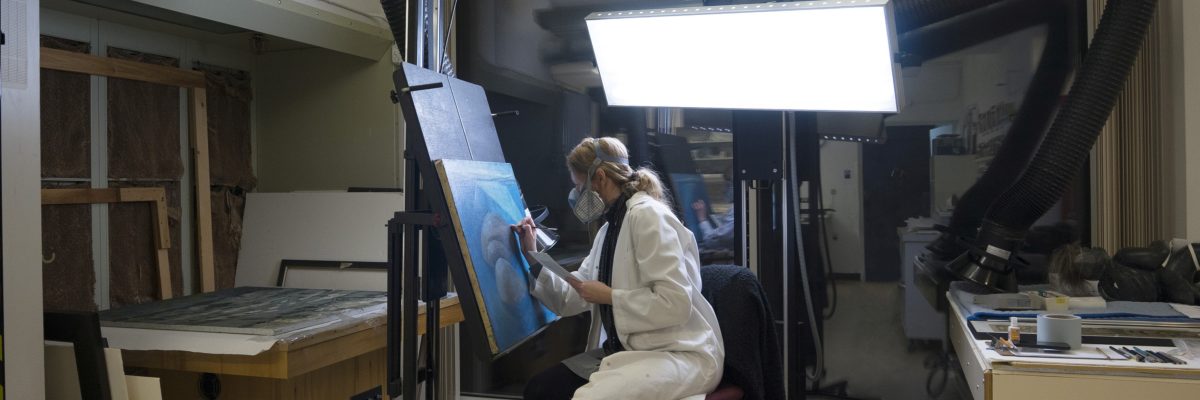
Barbara A. Ramsay
Barbara A. Ramsay Receives the 2022 CAPC Award of Distinction
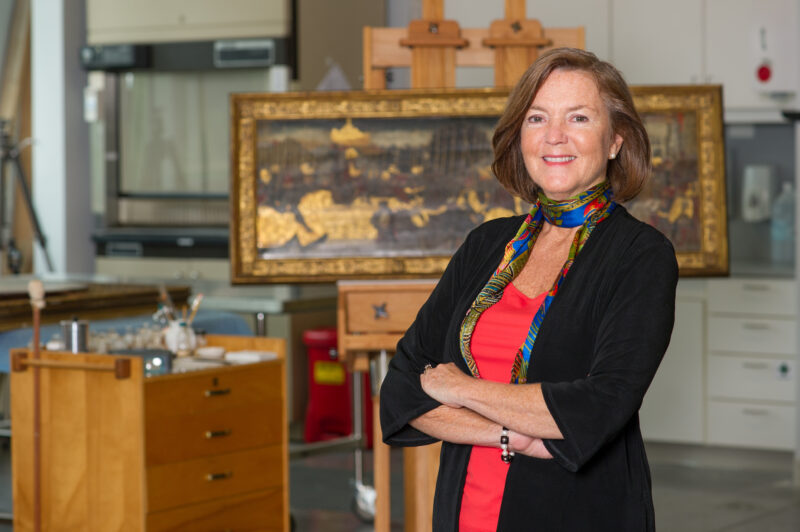
Barbara A. Ramsay as new Chief Conservator at The John & Mable Ringling Museum of Art, Sarasota, Florida, 2014 (Photo: Peter Acker)
Interview by Melissa Allen, August 2022
Earlier this summer, I had the pleasure of interviewing Barbara A. Ramsay, this year’s recipient of the Canadian Association of Professional Conservators (CAPC) Award of Distinction. As we spoke, it became clearer how deserving of this honour Barbara is, not only because of her experience, accomplishments, dedication to teaching, and countless hours of volunteering in support of CAPC and other organizations, but because she has made it a point of pride in her career to support her mentors, colleagues, and mentees. During our interview she made it very apparent how grateful she feels to be a part of this profession, and I hope that with this award she knows the feeling is mutual.
The story of Barbara A. Ramsay’s journey to conservation is both universal and charmingly unique. In high school, Barbara felt an equal interest in both art and science. Initially, pursuing what she deemed to be the more practical course, she earned her Bachelor of Science in Biology at the University of Toronto. After completing her degree, however, she realized the call of art still had her in its grips, leading to “a complete about-face” and her pursuit of studies in art history and studio art at U of T. A six-week trip through western Europe, and its many illustrious museums, clarified for Barbara that while she didn’t want to give up science, she had to find a career that related to art as well. Aware of this ambition, an art history professor showed her a brochure for a new art conservation program that was ‘made for her’—at the Canadian Conservation Institute. However, because the brochure was that professor’s only copy, she refused to give it up, and sent Barbara downtown to the U of T art history office. In a twist of fate, when Barbara went to get her own copy, she mistakenly picked up a brochure for the new Master of Art Conservation program at Queen’s University. Having acquired all the necessary prerequisites, not through a specific ambition to join the program but a pursuit of her varied interests, Barbara was the perfect candidate and was accepted into the first class in 1974. In her words “It’s just always been what I was supposed to be.”
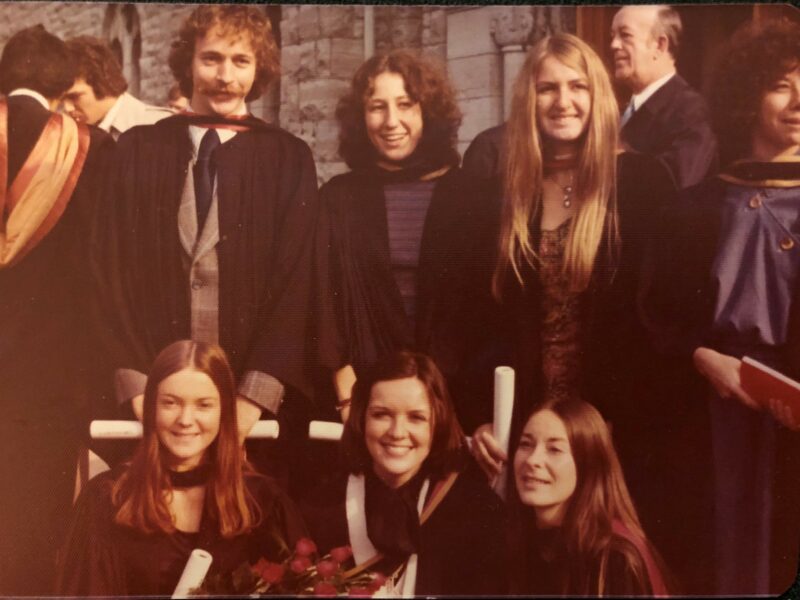
Ramsay at Queen’s University MAC graduation with class of ‘76
Barbara loved her time in the program at Queen’s. After studying in a temporary lab in the first year, she and her fellow MAC’76 graduate students moved into the new building on 15 Bader Lane in their second year. This building would remain virtually unchanged for the next forty-odd years but is now hosting its last class of students, as it is scheduled to be demolished in 2023—to make way for a new facility. Barbara described how inspired she was by her time at Queen’s, her classmates, and her professors—especially recent 2022 appointee to the Order of Canada, Ian Hodkinson, saying “Ian was such a knowledgeable and enthusiastic teacher and our class consisted of fascinating people from different academic backgrounds. It was wonderful.”
Barbara’s specialization was in paintings conservation. She spent her first summer internship with supervisor Christoph von Imhoff at Parks Canada, working on polychromed sculpture; her second summer internship was at the National Gallery of Canada treating easel paintings with Mervyn Ruggles and Rustin Levenson, and in Nova Scotia working on wall paintings with Hodkinson’s team of students. These opportunities provided more excellent mentors and reinforced a ‘learn by doing’ approach that would inspire her own teaching style. Barbara recalled her trepidation when asked by her Parks Canada supervisor von Imhoff, to describe what she saw when looking through a microscope at a polychromed sculpture for the first time. “It was terrifying but quite amazing,” Barbara said, “He insisted that you look and puzzle it out on your own, then he drew out of you just how much you actually did see and could interpret... It made so much sense, rather than just telling you what you should be seeing. If you have to figure it out for yourself, it means a lot.”
Barbara described her time at Queen’s as providing a foundation of openness toward and awareness of the material aspect of conservation treatment. This has served her well throughout her career as she continues to use a broad range of conservation materials—both traditional and modern—critically, and on a case-by-case basis. “In a lot of what we do, it’s not even what the material is, it’s how we use it that can make all the difference.”
After graduating with an MAC degree in 1976, Barbara spent a year in Kingston in an Art Gallery of Ontario internship, conserving provincial art collections as well as historic painted finishes at Glanmore house in Belleville. In 1977, she was hired as Assistant Conservator of Fine Art, Paintings at the National Gallery of Canada, where, over the next thirteen years, she rose to Senior Conservator of Fine Art (1990-1995), practicing painting conservation and managing the Sculpture & Decorative Arts Conservation Laboratory. Describing this time in her career Barbara said, “Although I worked at the Gallery for many years, during that time I also pursued other professional opportunities that presented themselves.” Well-respected Head of Conservation Ursus Dix approved her leave of absence to participate in a six-month internship in fresco and polychromed stone conservation with Théo-Antoine Hermanès at Atelier CREPHART in Switzerland (1979-1980) and another leave to teach at Queen’s as a Visiting Associate Professor of paintings conservation (1983-1984). While initially somewhat daunted by the prospect of filling in for Hodkinson while he was on sabbatical, Barbara loved the role. She reflected that her mistake might have been “trying, in one year, to teach students everything that I had learned in nearly ten years.” But her students were enthusiastic and up to the challenge, according to Barbara “They would always tease that they would go through three pens in each lecture because everyone was taking notes by hand.”

Ramsay at Atelier CREPHART conserving polychromed stone sculpture at la Cathédrale de Lausanne, 1980
In 1999 Barbara and her sons moved to Washington, DC, where she established and then managed the ARTEX Conservation Laboratory. The move was prompted in part by the 1995 recession in Canada, which forced the National Gallery to cut 25% of its budget. As a result, her position of Senior Conservator of Fine Art was suddenly eliminated after her 18 years at the museum. “It nearly killed me when that happened, because my work formed the core of my identity.” Barbara stayed on at the Gallery for two more years, as an Exhibitions Project Manager and then Head of Travelling Exhibitions—while teaching part time at Queen’s as an Adjunct Associate Professor of painting conservation and coordinating a national conservation internship program that she had helped to establish. Barbara described her twenty years at the Gallery—working on the national collections alongside respected colleagues—as an honour and a privilege. However, her move to ARTEX would provide other incredible opportunities that Barbara acknowledges she would not have otherwise had.
One of those exciting opportunities began when the widow of the American Abstract Expressionist painter, Clyfford Still, moved the entire estate of the artist—3,412 works, including 836 paintings—to storage at ARTEX. What began as a condition assessment of twenty of those paintings turned into an eight-year-long research and conservation treatment project that Barbara includes as among the most satisfying of her career. The project provided a unique intimacy with the work of an artist she admired very much, “Unrolling these magnificent paintings that hadn’t been looked at for decades, you could still smell the linseed oil.” She became the first conservator for the estate and one of the first to be granted permission to access Still’s archives before the collection was moved to the new Clyfford Still Museum in Denver. This work, undertaken with her staff conservators at ARTEX and in collaboration with Dr. Susan Lake, Head of Collections and Conservation at the Hirshhorn Museum & Sculpture Garden in Washington, DC and scientists at the Getty Conservation Institute, resulted in a book for the Getty’s The Artist’s Materials series. It was a project that felt serendipitous in that one of the first paintings Barbara had examined when hired by the National Gallery of Canada happened to be a Clyfford Still. “Twists of fate, my life has been full of them. Crazy turns that have ended up being amazing experiences.”
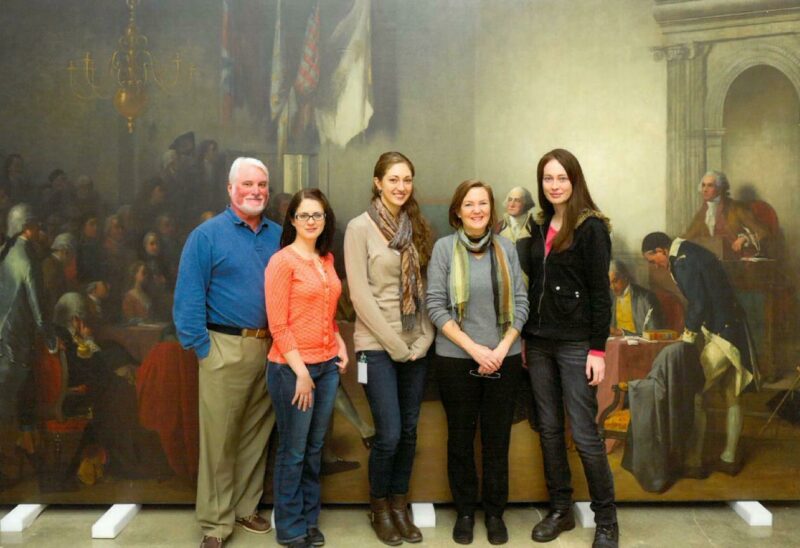
Ramsay and her conservation staff at ARTEX Conservation Laboratory, Washington, DC, 2013
In another twist, in 2013, a conservator friend alerted Barbara to the opening of the position of Chief Conservator at The John & Mable Ringling Museum of Art in Sarasota, Florida, thinking it would be perfect for her. Barbara has been in this position for almost 9 years now and is proud to contribute to the preservation of the Ringling legacy. In her words, “At The Ringling, I have been able to put to good use everything that I have learned over the course of my 48 years in this profession.”
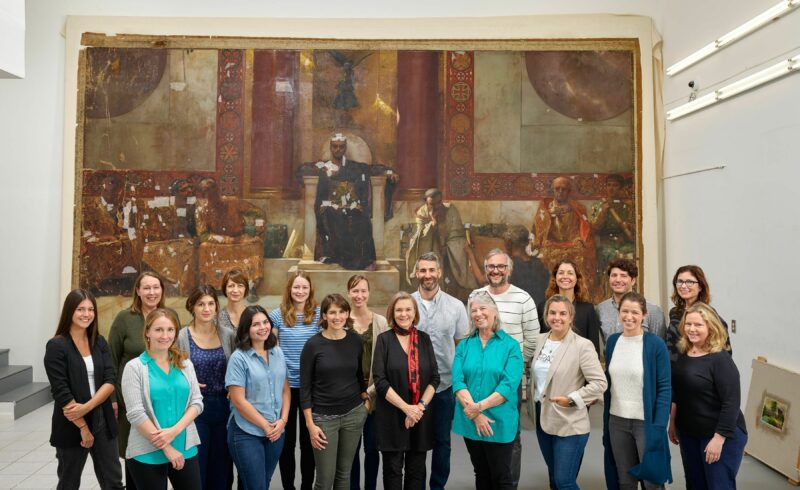
Ramsay with conservation team for The Ringling-Getty Foundation Conserving Canvas project, ArtCare Conservation, Miami, 2019. Jean-Joseph Benjamin-Constant Emperor Justinian, 1886 (during treatment). Bequest of John Ringling, 1936 (Photo: Daniel Portnoy Photography)
Through all the developments of her career, Barbara carried with her the ethical guidelines first established at Queen’s. Barbara’s passion for the high ethical and professional standards of the field contributed to her dedication to the IIC-CG, CAPC, CAC, IIC, ICOM-CC, and other professional associations. She has held numerous positions including Chairman of the Board of Directors of CAPC (1989-1993); President of the Executive Committee and First Director of IIC-CG (1985-1987); Member of Editorial Committee for the Journal of the IIC-CG, Journal of CAC (1978-present), and Co-editor (1994-1999), and many more. Barbara has been on more than 25 Boards of Examination for CAPC both in English and in French, the most recent in 2020. She described how in the early days of CAPC, the examiners were not only volunteering their time but would also absorb any necessary financial costs associated with traveling to perform studio visits and interviews for accreditation. “That’s just what we did, because it had to be done.”
I was curious to know how Barbara’s move south of the border might have impacted her relationship with CAPC, but Barbara says she still feels a strong connection to the Association today. She firmly believes in the purposes for which CAPC was established, citing the value of CAPC to the individual conservator, the profession as a whole and the public being served. “It’s always been very important to me. It’s something I learned about from almost my first day at Queen’s, because Ian was instrumental in setting up the organization and letting us know how important it was for the profession.” She expressed some disappointment at the continued challenges of the organization to make inroads in accrediting many institutional conservators, but pride at the positive influence the organization has had and continues to have on the field saying, “I put my heart and soul into strengthening and growing the organization and to implementing procedures that would ensure there was appropriate examination of professional conservators. I am pleased to see the fine work being done by CAPC today.”
Over the past four and a half decades Barbara has mentored many students, interns, Fellows, and staff, saying, “It’s a very important part of what I do.”
She described how gratifying it has been to see what her various students and mentees have gone on to accomplish in their careers, and acknowledged how much she appreciates the opportunity to continue to learn from her interns, Fellows, and junior staff as well. Barbara was unequivocal in expressing her gratitude to all the mentors and colleagues she has worked with, as well as all those conservators and conservation scientists who came before her. Through her career, Barbara has consciously maintained professional connections, continuing to work with Queen’s students, graduates, and professors even after moving to the U.S. In a particularly wonderful circumstance, provided through a Getty Foundation Conserving Canvas grant that she secured in 2019 for The Ringling, Barbara was able to invite eight early- and mid-career painting conservators to participate in a treatment and training project, working with Oliver Watkiss and Rustin Levenson at ArtCare Conservation in Miami. The group conserved The Ringling’s 13’ x 22’ painting of Emperor Justinian, by French painter Jean-Joseph Benjamin-Constant and participated in a training workshop on glue-paste lining at ArtCare. The conservation team she assembled included her staff conservator, as well as current and former interns, Fellows, and employees who had moved on to other positions, plus two additional conservators from Canada and Colombia. In addition, the experts panel included her mentor from Queen’s and one of the students she had taught at Queen’s in 1983-1984. Two graduates of the Queen’s MAC program, who are now professors of painting conservation in the Queen’s and SUNY Buffalo programs, also participated. “It was an incredible project where we had pioneers of conservation working with emerging conservators and this monumental painting that had to be treated. Everything came together so well, but it was most satisfying to see all of these conservators—with whom I had worked over the course of my career—coming together and renewing relationships with colleagues they had worked with previously, and forming new, lifelong friendships. It was just wonderful, absolutely amazing.”

Ramsay and her Queen’s MAC students (classes of ’84 and ’85), Kingston, 1984
In speaking with Barbara, I got the very clear sense of a person who has approached her life and career in conservation with enthusiasm, dedication, and determination. “I always like where I am and love what I’m doing. That has never changed.” As to where Barbara will go from here, she continues to thrive in her work at The Ringling and is re-building the conservation staff ‘post’ COVID-19. When asked about future research, Barbara stated quite plainly that she had no current plans following the recent publication of Clyfford Still: The Artist’s Materials. However, she went on to describe a project started in the 80’s and once enthusiastically supported by Dr. Robert Feller, involving an investigation into the solubility of naturally-aged butyl-methacrylate varnishes on paintings at the National Gallery of Canada. Perhaps a final twist of fate is still in store? Barbara admits “I still have my files here...you never know.”
______________________________________
[1] Select list of PROFESSIONAL AFFILIATIONS - MEMBERSHIP AND ACTIVITIES:
AMERICAN INSTITUTE FOR CONSERVATION OF HISTORIC AND ARTISTIC WORKS (AIC). Member since 1978. Professional Associate since 1999.
AMERICAN ALLIANCE OF MUSEUMS (AAM). Member 1999 to 2004, 2014 to present.
CANADIAN ASSOCIATION FOR CONSERVATION OF CULTURAL PROPERTY (CAC), formerly the INTERNATIONAL INSTITUTE FOR CONSERVATION - CANADIAN GROUP (IIC-CG). President of the Executive Committee and First Director, 1985-87; Member of Editorial Committee for the Journal of the CAC (IIC-CG) from 1978 to present, Co-editor from 1994-99; Committee member for Federal Museum Policy submissions, 1985-88; Chairman of Conference Translation Committee, 1986; Member of IIC-CG/CAPC Code of Ethics Committee, 1984-86; Councillor, Executive Committee, 1982-84; Chairman of Membership Committee, 1980-82; Member of Conference Translation Committee, 1980-81; Chairman of Liaison Committee, 1978-79; Individual member since 1977.
CANADIAN ASSOCIATION OF PROFESSIONAL CONSERVATORS (CAPC). Chairman of Board of Directors, 1989-1993; Reviewer of CAC/CAPC Code of Ethics, 1999; Member of CAPC/CAC Joint Committee on Cooperation, 1997-98; Co-Chairman of Code of Ethics Committee and Chairman of By-laws Review Committee, 1994-95; Vice-Chairman of Executive Council, 1987-89; Standing Member of Board of Examiners, 1987-93, occasional Member of Board of Examiners, 1996-2020; Member of IIC-CG/CAPC Code of Ethics Committee, 1988-89; Professional member since 1985.
CANADIAN MUSEUMS ASSOCIATION (CMA). Individual Member, 1976-99.
HEDLEY RESEARCH FELLOWSHIP FUND (CANADA), Ottawa. Founding Member, 1990 and Trustee 1992-99. Facilitate establishment of charitable status of the Trust by registration as a public foundation. On organizing committee for Hedley Forum in 1991, 1992, and 1993.
HERITAGE PRESERVATION – Nominating Committee member 2010-2013.
INTERNATIONAL COUNCIL OF MUSEUMS - COMMITTEE FOR CONSERVATION (ICOM-CC). Editor of ICOM-CC Newsletter, website, and Directory Board correspondence, 2003. Member of Preprints Committee for Preprints of the Fifteenth Triennial Meeting, (2008), Eleventh Triennial Meeting (1996), and the Tenth Triennial Meeting (1993); Member of Working Group on Training in Conservation and Restoration, and on Resin Coatings: Evaluation and Characterization; Working Group on Training, Regional Assistant Coordinator, 1981-84; Ordinary individual membership in ICOM from 1977-96, and since 1999.
INTERNATIONAL INSTITUTE FOR CONSERVATION OF HISTORIC AND ARTISTIC WORKS (IIC), London, UK. Member of Council, 1995-2001 and 2006-2009; Elected a Fellow of the Institute, 1991; Associate member since 1977. Art and Archaeology Technical Abstracts: Regional Editor (Canada) 1988-2002; Abstractor 1977-2007.
OTTAWA REGIONAL CONSERVATION GROUP (ORG). Chairman of Liaison with IIC-CG, 1981-83. Chairman of Arrangements Committee, 1977-79, 1980-81; Member 1976-92.
ONTARIO MUSEUM ASSOCIATION (OMA). Chairman of Conservation Committee, 1978-79; Member 1978-80.
WASHINGTON CONSERVATION GUILD (WCG). Member of Nominations Committee, 2005. Member 1999-2012.
